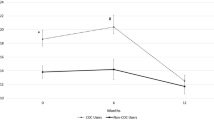Abstract
The purpose of the present study was to determine the effects of oral contraceptive therapy on bone density and serum markers of bone metabolism in a prospective, longitudinal study of young adult female cynomolgus monkeys. Two hundred and seven intact cynomolgus monkeys were randomized to two groups, and fed an atherogenic diet containing either no drug (Control) or a triphasic oral contraceptive regimen (Contraceptive). Measurements of bone density were carried out by dual-energy X-ray absorptiometry at 10-month intervals (0, 10, and 20 months) and serum bone biomarkers were determined at 5-month intervals over the 20-month time course. No significant differences in these variables were observed prior to treatment. Both groups of animals gained bone mineral during the study, indicating that peak bone mass had not been reached at baseline. Contraceptive-treated animals gained less spinal (lumbar vertebrae 2–4) bone mineral content and density and less whole-body bone mineral content than Controls over the course of the study. Significant depressive effects of contraceptive treatment on gains in BMC and BMD were observed during each 10-month interval of the study. Bone metabolism was inhibited in the Contraceptive group, as reflected by marked reductions (∼ 40%) in serum osteocalcin and alkaline phosphatase levels along with moderate reductions in serum acid phosphatase and calcium. The results suggest that triphasic oral contraceptive treatment of young adult female monkeys that have not reached peak bone mass inhibits net bone accretion and/or growth by reducing bone metabolism. Thus, prolonged continuous oral contraceptive use in skeletally immature females may lead to a lower peak bone mass — an effect which could increase the risk of fractures in later life.
Similar content being viewed by others
References
Mehta S. Bone loss, contraception and lactation. Acta Obstet Gynecol Scand 1993;72:148–56.
Goldsmith NF, Johnston JO. Bone mineral: effects of oral contraceptives, pregnancy, and lactation. J Bone Joint Surg Am 1975;57:657–68.
Kanders B, Lindsay R, Dempster D, et al. Determinants of bone mass in young healthy women. In: Christiansen C, Arnaud CD, Nordin BEC, Parfitt AM, Peck WA, Riggs BL, editors. Osteoporosis 1984: Proceedings of the Copenhagen International Symposium on Osteoporosis. Copenhagen: Osteopress, 1984: 337–9.
Shargil AA. Hormone replacement therapy in perimenopausal women with a triphasic contraceptive compound: a three year prospective study. Int J Fertil 1985;30:18–28.
Lindsay R, Tohme J, Kanders B. The effect of oral contraceptive use on vertebral bone mass in pre- and post-menopausal women. Contraception 1986;34:333–40.
Enzelsberger H, Metka M, Heytmanek G, Schurz B, Kurz B, Kusztrich M. Influence of oral contraceptive use on bone density in climacteric women. Maturitas 1988;9:375–8.
Stevenson JC, Lees B, Devenport M, Cust MP, Ganger KF. Determinants of bone density in normal women: risk factors for future osteoporosis? BMJ 1989;298:924–8.
Kleerekoper M, Brienza RA, Schultz LR, et al. Oral contraceptive use may protect against low bone mass. Arch Intern Med 1991;151:1971–6.
Recker RR, Davies KM, Hinders SM, Heaney RP, Stegman MR, Kimmel DB. Bone gain in young adult women. JAMA 1992;268:2403–8.
Kritz-Silverstein D, Barrett-Connor E. Bone mineral density in postmenopausal women as determined by prior oral contraceptive use. Am J Publ Health 1993;83:100–2.
Johnell O, Nilsson BE. Life-style and bone mineral mass in perimenopausal women. Calcif Tissue Int 1984;36:354–6.
Hreshchyshyn MM, Hopkins A, Zylstra S, Anbar M. Association of parity, breast-feeding, and birth control pills with lumbar spine and femoral neck bone densities. Am J Obstet Gynecol 1988;159:318–22.
Lloyd T, Buchanan JR, Urismo GR, Myers C, Woodward G, Halbert DR. Long-term oral contraceptive use does not affect trabecular bone density. Am J Obstet Gynecol 1989;160:402–4.
Rodin A, Chapman M, Fogelman I. Bone density in users of combined oral contraception. Br J Fam Planning 1991;16:125–9.
Mazess RB, Barden HS. Bone density in premenopausal women: effects of age, dietary intake, physical activity, smoking and birth-control pills. Am J Clin Nutr 1991;53:132–42.
Hansen MA. Assessment of age and risk factors on bone density and bone turnover in healthy premenopausal women. Osteoporos Int 1994;4:123–8.
Fortney J, Feldblum PJ, Talmage RV, Zhang J, Godwin SE. Bone mineral density and history of oral contraceptive use. J Reprod Med 1994;39:105–9.
Cooper C, Hannaford P, Croft P, Kay CR. Oral contraceptive pill use and fractures in women: a prospective study. Bone 1993;14:41–5.
Polatti F, Perotti F, Filippa N, Gallina D, Nappi RE. Bone mass and long-term monophasic oral contraceptive treatment in young women. Contraception 1995;51:221–4.
Mahoney CJ. A study of the menstrual cycle inMacaca irus with special reference to the detection of ovulation. J Reprod Fertil 1970;21:153–63.
Jayo MJ, Rankin SE, Weaver DS, Carlson CS, Clarkson TB. Accuracy and precision of lumbar bone mineral content by dual-energy X-ray absorptiometry in live female monkeys. Calcif Tissue Int 1991;49:438–40.
Jerome CP, Carlson CS, Register TC, et al. Bone functional changes in intact, ovariectomized, and ovariectomized, hormone-supplemented adult cynomolgus monkeys(Macaca fascicularis) evaluated by serum markers and dynamic histomorphometry. J Bone Miner Res 1994;9:527–40.
Kaplan JK, Adams MR, Anthony MS, Morgan TM, Manuck SB, Clarkson TB. Dominant social status and contraceptive hormone treatment inhibit atherogenesis in premenopausal monkeys. Arterioscler Thromb Vasc Biol 1995;15:2094–100.
Osteoporosis. National Institutes of Health Consensus Conference Consensus Statement 1984;5(3):6 pp.
Jayo MJ, Jerome CP, Lees CJ, Rankin SE, Weaver DS. Bone mass in female cynomolgus macaques: a cross-sectional and longitudinal study by age. Calcif Tissue Int 1994;54:231–6.
Hauschka PV, Lian JB, Cole DE, Gundberg CM. Osteocalcin and matrix gla protein: vitamin K dependent proteins in bone. Physiol Rev 1989;69:990–1047.
Garnero P, Sornay-Rendu E, Delmas P. Decreased bone turnover in oral contraceptive users. Bone 1995;16:499–503.
Author information
Authors and Affiliations
Corresponding author
Rights and permissions
About this article
Cite this article
Register, T.C., Jayo, M.J. & Jerome, C.P. Oral contraceptive treatment inhibits the normal acquisition of bone mineral in skeletally immature young adult female monkeys. Osteoporosis Int 7, 348–353 (1997). https://doi.org/10.1007/BF01623776
Received:
Accepted:
Issue Date:
DOI: https://doi.org/10.1007/BF01623776




